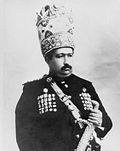Top Qs
Timeline
Chat
Perspective
Commander-in-Chief of the Iranian Armed Forces
Authority position in Iran From Wikipedia, the free encyclopedia
Remove ads
The position of Commander-in-Chief (Persian: فرمانده کل قوا, romanized: Farmandehe Koll-e Qova), formerly known as Bozorg Arteshtārān (Persian: بزرگ ارتشتاران, lit. 'Great Army Leader'), is the ultimate authority of all the Islamic Republic of Iran Armed Forces, and the highest possible military position within the Islamic Republic of Iran. The position was established during the Persian Constitutional Revolution. According to the Constitution of Iran, the position is vested in the Supreme Leader of Iran and is held since 1981.
After the 1979 Iranian Revolution and 15 days after the inauguration of the first president Abolhassan Banisadr in February 1980, Ayatollah Ruhollah Khomeini delegated him as the Commander-in-Chief.[1] According to Akbar Hashemi Rafsanjani, this was due to the illness of Ayatollah Khomeini and his concerns about the future of the revolution (in his absence).[2] In the decree from Khomeini to Banisadr it is mentioned:
At this critical stage where the need to concentrate forces is greater than any stage, you are appointed as my representative to the position of the Commander-in-Chief of the Armed Forces in the manner determined by the Constitution of the Islamic Republic of Iran.[1]
Following the impeachment of Banisadr in June 1981, the title of Commander-in-Chief was not transferred to the next president Mohammad-Ali Rajai, and is kept to this day by the Supreme Leader of the Islamic Republic of Iran.
Remove ads
List of commanders-in-chief
Remove ads
See also
Notes
- Appointed by the Parliament of Iran.[4]
- Mosaddegh was granted emergency powers by Shah of Iran to rule by decree.[6] While holding office as the Prime Minister and Minister of War (renamed to "Ministry of National Defence") simultaneously, Mossadegh went over the authority of Shah, the Commander-in-Chief vetted in the Persian Constitution of 1906, and appointed commanders in Imperial Iranian Army and Police.[7]
- Delegated by the Supreme Leader of Iran.[8]
- (Akbar Rafsanjani, acted as the de facto commander-in-chief since mid-1980s[10]and was later officially appointed as the deputy commander-in-chief on 2 June 1988.[11] Hassan Rouhani, served as deputy to second-in-command since 1988[12])
- He was caretaker of the Islamic Revolutionary Guard Corps, the highest position in the corps.[13] At the time military ranks were not used.
References
Wikiwand - on
Seamless Wikipedia browsing. On steroids.
Remove ads















